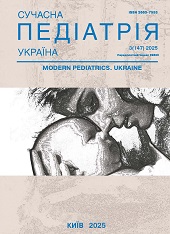Association between plasma surfactant proteins A and D levels and types of respiratory therapy in preterm neonates
DOI:
https://doi.org/10.15574/SP.2025.3(147).5559Keywords:
respiratory distress syndrome, preterm infants, surfactant proteins, surfactant proteins D, surfactant proteins A, respiratory therapyAbstract
Surfactant proteins A (SP-A) and D (SP-D) are key components of the pulmonary surfactant system and play important roles in lung immunity and homeostasis. Their plasma levels may reflect pulmonary maturity and disease severity in preterm neonates.
Aim: to evaluate the association between plasma levels of SP-A and SP-D and the type of respiratory therapy administered to preterm neonates.
Material and methods. A total of 114 preterm neonates treated in multiple neonatal intensive care units (NICUs) were categorized based on initial respiratory support - non-invasive (e.g., CPAP, NIPPV) or invasive ventilation. Plasma SP-A and SP-D levels were measured using ELISA. The statistical analysis was performed to assess correlations with therapy type, diagnosis, and outcomes.
Results. Of the neonates initially managed with non-invasive therapy, 60.6% required escalation to invasive ventilation. Plasma SP-A and SP-D levels were significantly higher in those requiring invasive support compared to those maintained on non-invasive therapy. Repeated surfactant dosing and lower APGAR scores were also associated with elevated protein levels and escalation therapy. Although trends were observed in the group initially receiving invasive ventilation, statistical significance was limited by the small sample size.
Conclusion. Elevated plasma SP-A and SP-D levels are associated with an increased need for invasive respiratory support in preterm neonates. These proteins may serve as useful biomarkers for predicting respiratory therapy needs and monitoring treatment responses. Further large-scale studies are needed to validate their clinical utility.
The research was carried out in accordance with the principles of the Declaration of Helsinki. The informed consent of the patient was obtained for conducting the studies.
No conflict of interests was declared by the authors.
References
Bersani I, Speer CP, Kunzmann S. (2012, May). Surfactant proteins A and D in pulmonary diseases of preterm infants. Expert Rev Anti Infect Ther. 10(5): 573-584. https://doi.org/10.1586/eri.12.34; PMid:22702321
Hentschel R, Bohlin K, van Kaam A et al. (2020). Surfactant replacement therapy: from biological basis to current clinical practice. Pediatr Res. 88: 176-183. https://doi.org/10.1038/s41390-020-0750-8; PMid:31926483 PMCid:PMC7223236
Kaltsogianni O, Dassios T, Greenough A. (2023). Neonatal respiratory support strategies - short and long-term respiratory outcomes. Front. Pediatr. 11: 1212074. https://doi.org/10.3389/fped.2023.1212074; PMid:37565243 PMCid:PMC10410156
Mapindra MP, Castillo-Hernandez T, Clark H, Madsen J. (2025, Jan 1). Surfactant Protein-A and its immunomodulatory roles in infant respiratory syncytial virus infection: a potential for therapeutic intervention? Am J Physiol Lung Cell Mol Physiol. 328(1): L179-L196. Epub 2024 Dec 11. https://doi.org/10.1152/ajplung.00199.2024; PMid:39662519
Pastva AM, Wright JR, Williams KL. (2007, Jul). Immunomodulatory roles of surfactant proteins A and D: implications in lung disease. Proc Am Thorac Soc. 4(3): 252-7. https://doi.org/10.1513/pats.200701-018AW; PMid:17607008 PMCid:PMC2647627
Watson A, Madsen J and Clark HW. (2021). SP-A and SP-D: Dual Functioning Immune Molecules With Antiviral and Immunomodulatory Properties. Front. Immunol. 11: 622598. https://doi.org/10.3389/fimmu.2020.622598; PMid:33542724 PMCid:PMC7851053
Yue G, Wang J, Li H, Li B, Ju R. (2021, Jul 30). Risk Factors of Mechanical Ventilation in Premature Infants During Hospitalization. Ther Clin Risk Manag. 17: 777-787. https://doi.org/10.2147/TCRM.S318272; PMid:34354359 PMCid:PMC8331080
Downloads
Published
Issue
Section
License
Copyright (c) 2025 Modern pediatrics. Ukraine

This work is licensed under a Creative Commons Attribution-NonCommercial 4.0 International License.
The policy of the Journal “MODERN PEDIATRICS. UKRAINE” is compatible with the vast majority of funders' of open access and self-archiving policies. The journal provides immediate open access route being convinced that everyone – not only scientists - can benefit from research results, and publishes articles exclusively under open access distribution, with a Creative Commons Attribution-Noncommercial 4.0 international license (СС BY-NC).
Authors transfer the copyright to the Journal “MODERN PEDIATRICS. UKRAINE” when the manuscript is accepted for publication. Authors declare that this manuscript has not been published nor is under simultaneous consideration for publication elsewhere. After publication, the articles become freely available on-line to the public.
Readers have the right to use, distribute, and reproduce articles in any medium, provided the articles and the journal are properly cited.
The use of published materials for commercial purposes is strongly prohibited.

